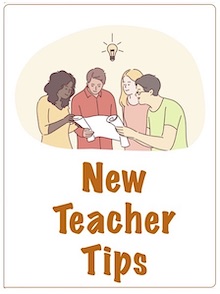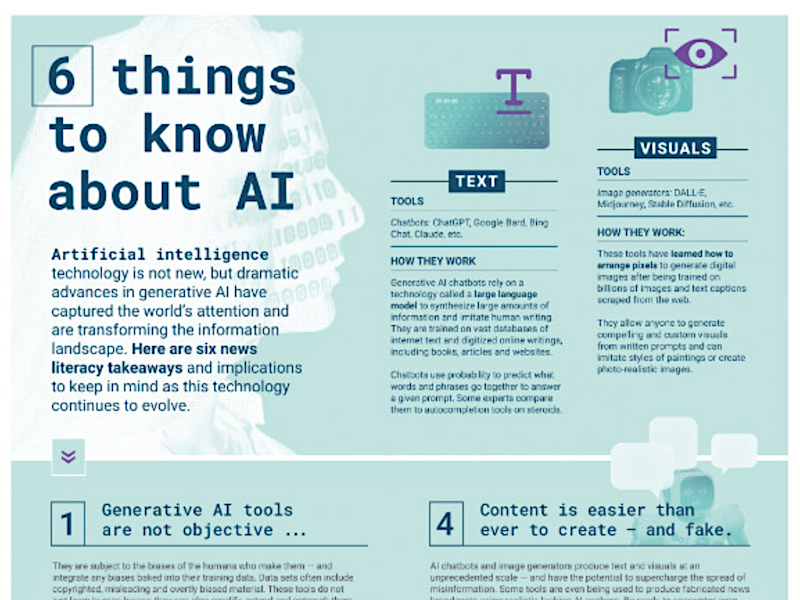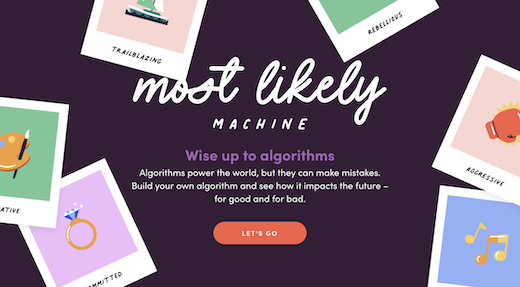What Will You Teach Your Students About AI?
A MiddleWeb Blog
 For most of us, teaching and using Artificial Intelligence can seem frightening. Despite any apprehension we feel, the truth remains that AI is an essential topic for our classroom this year.
For most of us, teaching and using Artificial Intelligence can seem frightening. Despite any apprehension we feel, the truth remains that AI is an essential topic for our classroom this year.
AI Anxiety
Artificial Intelligence is rapidly changing many aspects of our lives including how we work, communicate, find/evaluate information, and teach. As a result, there’s been an uptick in “AI anxiety” for many educators.
AI anxiety is very real, widely documented, and refers to the uneasiness or fear that we experience as we contemplate negative outcomes and risks to ourselves and others using AI (Wang & Wang, 2022).
Despite widespread worry about Artificial Intelligence, it’s also true that – if we educate ourselves about AI’s pitfalls and potential – it can serve as a powerful tool for learning by helping provide feedback, tutoring, and personalized learning experiences.
With the opening days of school upon us, let’s explore one question on the mind of nearly every educator – How (and what) do I teach my students about AI?
Suggested Topics on What to Teach
As complex and far-reaching as AI is, it can be challenging to know what topics to discuss with your students. As a jumping off point, teachers might consider the following AI essentials:
►Common use of AI in everyday life, or a discussion of how AI is used not just in chatbot interfaces but in smartphone technology, gaming, music/video streaming, social media, and shopping.
►What AI is and how it works, including basic concepts like machine learning, algorithms, and data. For example, see this quick introductory video from Common Sense Media for teachers and students.
Additionally, you’ll want to spend some class time teaching about the creative applications of AI and the practical skills needed for doing so. For example…
►Discuss (and if possible demonstrate) how AI can be used to generate music, written texts, images, and art)
►AI and problem-solving: Show how AI can be used to solve real-world problems. Consider skimming this article and selecting a few examples likely to pique your students’ interests.
►Data analysis: Teach students how AI can collect, analyze, and interpret data using activities like AI for Oceans.
Finally, educators should spend time exploring the ethical considerations of Artificial Intelligence. For instance (click on links to see examples):
►Consent, data security, and privacy. AI tools often gather information from users such as usage patterns, search history, and personal information. Help students know how to identify and adjust what information is being collected in order to keep their personal info as private as possible.

►Authenticity, misinformation and deepfakes. Educate students on how easily AI can create phony, yet widely circulated and seemingly realistic images, video, audio. Discuss the challenges faced by each of us in verifying information we encounter and the potential harm of accidentally sharing false information with others.
►Avoiding plagiarism. Encourage students to take steps to clearly understand each teacher’s expectations about if, when, and how to use AI in class. Also, teach them to properly and clearly cite sources, authorship, and other important details regarding the information that they include in assignments, assessments, and other learning tasks.
►Bias in artificial intelligence. Students need to understand that the very nature of AI makes it prone to bias, or decision making that favors one thing, person, or group compared with another. These biases include (but are not limited to) facial recognition, social media algorithms, gender, and race.
Ready to Go AI Lesson Plans
Not all of us feel comfortable designing our own activities, lessons, and units about Artificial Intelligence. Luckily, there are plenty of suggested activities and ready-to-go lesson plans to help educate our students and teachers about proper, effective use of AI.
►Commonsense.org has a bank of AI Literacy Lessons for Middle and High School teachers. These quick, grab-and-go modules are designed to help teachers and their students think critically about AI and its impact. Each 20 minute lesson provides information/activities that address AI’s social and ethical impacts. Topics include understanding what AI is and how it works, potential benefits and risks of AI, and thinking critically about responsible and ethical AI use.
►MoralMachine provides teachers and students moral dilemmas or scenarios where AI-powered, driverless cars must choose the lesser of two evils in a traffic situation. As an outside observer, you judge which outcome is more ethical. There is even a feature that allows you to design and discuss your own driverless car scenarios.
►AI Explained is a collection of well-designed videos about what Artificial Intelligence is and how it impacts your students.
►Though geared towards older middle school students, the AI Education Project has several project-based learning lessons that introduce the fundamentals of artificial intelligence.
►AI algorithms power the world but can make mistakes. That’s where Most Likely Machine comes in. This simulation helps students build their own algorithm and see how it impacts the future – for good and for bad. As they do so, students learn what algorithms are, what they are used for, and their potential for bias.
►Teachable Machine is a web-based tool that allows teachers and students to create their own learning machine. My class and I used this tutorial to learn the basics of training our laptops to discern between various types of objects, images, sounds, and much, much more.
In addition, the site has a few lesson ideas for developing understanding of bias in algorithms and for exploring the usefulness of AI in daily life.
Fear Not
Our role as educators is to provide those we teach with foundational knowledge of AI that empowers them to become responsible digital citizens and helps them navigate the increasingly AI-driven world.
Remember that we don’t have to be AI experts, and that the best way to learn something deeply …is to teach it. In order to successfully increase understanding and appreciation of Artificial Intelligence, we need only to embrace the journey of discovery with our students, fostering critical thinking and a spirit of innovation as we explore the ever-evolving world of AI together.
Reference
Wang, Y. Y., & Wang, Y. S. (2022). Development and validation of an artificial intelligence anxiety scale: An initial application in predicting motivated learning behavior. Interactive Learning Environments, 30(4), 619-634.
Resource
Ferlazzo, L. The Best New – & Free – Artificial Intelligence Tools That Could Be Used in the Classroom.






























